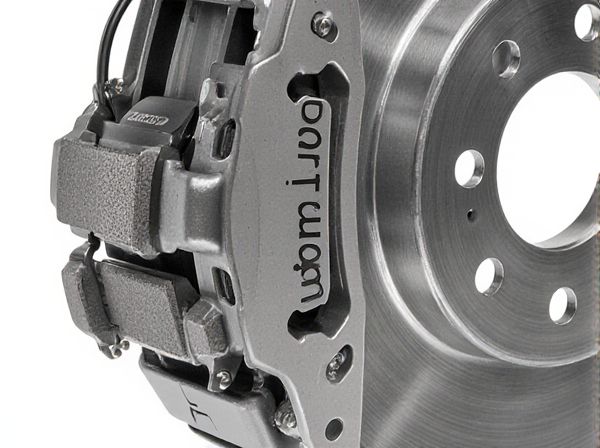
Photo illustration: Slotted Pad vs Chamfered Pad
Slotted pads provide enhanced cooling and debris removal due to their grooves, making them ideal for high-performance braking under heavy loads. Chamfered pads feature angled edges that reduce noise and prevent uneven wear, ensuring a smoother braking experience. Choose the pad type that best suits your driving style and vehicle requirements for optimal safety and performance.
Table of Comparison
| Feature | Slotted Pad | Chamfered Pad |
|---|---|---|
| Design | Grooves cut into the pad surface | Edges angled or beveled |
| Heat Dissipation | Improves airflow, reduces overheating | Moderate heat management |
| Noise Reduction | Minimizes brake squeal effectively | Reduces noise but less than slotted |
| Dust Management | Channels dust away for cleaner braking | Less efficient dust control |
| Pad Life | Longer due to better heat and dust management | Average lifespan |
| Performance | Superior for heavy-duty and performance driving | Smooth braking, ideal for daily driving |
Introduction to Brake Pad Designs
Slotted pads feature grooves that help dissipate heat, reduce brake fade, and expel gases and debris, enhancing overall braking performance. Chamfered pads have angled edges designed to minimize noise and prevent edge lifting or glazing during braking. Both designs optimize brake pad efficiency by targeting heat management and wear reduction, crucial for reliable and consistent stopping power.
What Are Slotted Brake Pads?
Slotted brake pads feature grooves or slots cut into the friction material to improve heat dissipation, reduce brake fade, and help channel away dust and gases generated during braking. These slots enhance braking performance by maintaining consistent pad-to-rotor contact and preventing glazing. Slotted pads are often preferred for high-performance and heavy-duty braking applications due to their ability to improve cooling and maintain braking efficiency.
What Are Chamfered Brake Pads?
Chamfered brake pads feature angled edges designed to reduce noise, vibration, and harshness (NVH) during braking by minimizing pad-to-rotor contact points. Unlike slotted pads, which have grooves to dissipate heat and gases, chamfered pads optimize smooth engagement and extend pad life by preventing uneven wear and chipping. These pads are commonly used in various vehicles to enhance braking performance and comfort.
Key Differences Between Slotted and Chamfered Pads
Slotted pads feature elongated slots that enhance cooling efficiency and debris removal, while chamfered pads have beveled edges designed to reduce noise and improve bedding-in performance. The key difference lies in their design focus; slotted pads prioritize heat dissipation and maintenance, whereas chamfered pads emphasize smooth engagement and extended pad life. Material composition and intended use also vary, with slotted pads often favored in high-performance or heavy-duty applications, and chamfered pads preferred for daily driving and quieter operation.
Performance Comparison: Slotted vs Chamfered Pads
Slotted pads offer enhanced heat dissipation and improved debris removal, resulting in superior braking performance during high-stress conditions compared to chamfered pads. Chamfered pads reduce noise and vibration by optimizing the contact edge, but may sacrifice some initial bite and cooling efficiency relative to slotted designs. For performance-focused applications, slotted pads provide better fade resistance and consistent stopping power under extreme heat buildup.
Noise and Vibration: Which Pad Is Quieter?
Slotted brake pads excel in noise reduction by allowing gases and debris to escape, minimizing vibration and brake squeal during operation. Chamfered pads reduce noise by tapering the edges, which prevents the pad from catching and causing vibrations but may not dissipate heat as effectively as slotted designs. Overall, slotted pads tend to be quieter under heavy braking due to better ventilation and heat management, while chamfered pads offer smoother, quieter engagement in everyday driving conditions.
Durability and Wear Patterns
Slotted pads offer superior heat dissipation, reducing thermal stress and enhancing overall durability compared to chamfered pads, which may suffer faster wear due to less efficient heat management. The slots in slotted pads help channel away debris and gases, leading to more consistent braking performance and even wear patterns, whereas chamfered pads can develop uneven wear at the edges under heavy usage. In high-stress applications, slotted pads maintain structural integrity longer, making them a preferred choice for longevity and reliability.
Suitability for Driving Conditions
Slotted pads offer superior heat dissipation and gas removal, making them suitable for high-performance driving and heavy braking conditions where thermal stability is crucial. Chamfered pads reduce noise, vibration, and harshness, fitting well with everyday driving scenarios and urban environments that require smooth, quiet braking. Selecting between slotted and chamfered pads depends on the vehicle's typical driving conditions, with slotted pads favored for aggressive driving and chamfered pads preferred for routine, stop-and-go traffic.
Cost and Maintenance Considerations
Slotted pads generally offer lower initial costs due to simpler manufacturing processes but may require more frequent maintenance to prevent debris accumulation in the slots. Chamfered pads, while often more expensive upfront because of the precision machining needed for the beveled edges, typically provide easier cleaning and longer service intervals, reducing overall maintenance expenses. Choosing between these pads depends on balancing upfront cost savings against potential maintenance frequency and longevity in specific applications.
Choosing the Right Brake Pad for Your Vehicle
Choosing the right brake pad for your vehicle involves understanding the key differences between slotted pads and chamfered pads. Slotted pads excel in heat dissipation and debris removal, making them suitable for high-performance or heavy-duty applications where managing brake temperatures is critical. Chamfered pads reduce noise and vibration, providing smoother braking performance ideal for everyday driving and standard vehicles.
 caratoz.com
caratoz.com